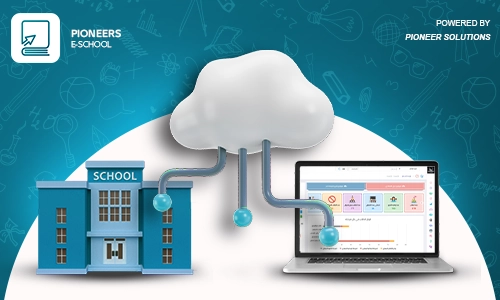In today’s fast-paced digital age, educational institutions are evolving rapidly to meet the demands of efficient administration and seamless communication. One transformative solution is the adoption of cloud-based school management systems. These systems offer an integrated platform to manage student records, attendance, grades, communication, and much more enhancing efficiency, security, and accessibility.
This article explores the critical role of cloud-based school management systems, highlighting their advantages and why they have become a necessity for modern educational institutions.
What is a Cloud-Based School Management System?
A cloud-based school management system is a digital solution hosted on a cloud platform that helps schools manage their operations and data online. Unlike traditional on-premises software, cloud systems enable users to access features and information remotely via the internet. These systems integrate various administrative and academic functionalities into one cohesive platform, making school management more effective and user-friendly.
Advantages of Cloud-Based School Management Systems
1. Streamlined Student Record Management
Keeping track of student records can be a daunting task, especially for schools with large enrollments. A cloud-based system simplifies this process by:
- Storing all data in one centralized location.
- Enabling quick access to information such as personal details, enrollment history, and academic progress.
- Allowing administrators and teachers to update records in real time, ensuring accuracy.
For example, when a teacher updates a student’s grades, parents and students can instantly access them through the portal, reducing delays and enhancing transparency.
2. Enhanced Attendance Tracking
Monitoring attendance is critical for maintaining discipline and tracking student performance. A cloud-based system automates this process:
- Teachers can mark attendance directly through an online interface.
- Parents receive instant notifications if their child is absent.
- Detailed attendance reports can be generated effortlessly, helping schools identify patterns and take corrective actions.
This functionality eliminates the need for paper-based attendance registers, saving time and reducing errors.
3. Simplified Grade Management
Managing grades manually is prone to errors and delays. Cloud-based systems offer robust grade management features:
- Teachers can input grades directly into the system, which automatically calculates averages and class rankings.
- Customized grading systems can be implemented to match institutional requirements.
- Students and parents can access grades immediately after they are published, fostering better communication and accountability.
4. Improved Communication
Efficient communication between students, parents, teachers, and administrators is crucial for the success of any school. Cloud-based systems bridge communication gaps through:
- Dedicated messaging systems for instant communication.
- Notifications and reminders for important events, deadlines, and announcements.
- Access to digital newsletters and circulars, reducing dependency on printed materials.
This enhanced communication strengthens the bond between the school and its community.
5. Accessibility Anytime, Anywhere
One of the standout features of cloud-based systems is their remote accessibility. Whether at home, school, or on the go, stakeholders can access the system via any device with an internet connection. This flexibility offers:
- Teachers the ability to plan lessons and input grades remotely.
- Parents the convenience of staying updated on their child’s progress.
- Administrators the capability to oversee operations from anywhere, enhancing productivity.
6. Scalability and Cost-Effectiveness
Cloud-based solutions are highly scalable, making them suitable for schools of all sizes. Whether managing a small institution or a large campus, the system can adapt to evolving needs. Additionally, these systems are cost-effective:
- Schools save on hardware and maintenance costs associated with traditional systems.
- Subscription-based pricing models allow schools to pay only for the features they use.
7. Data Security and Backup
Data security is a paramount concern for educational institutions. Cloud-based systems employ robust security measures, such as encryption and multi-factor authentication, to protect sensitive information. Additionally, automated backups ensure that:
- Data is never lost, even in the event of a hardware failure or cyberattack.
- Schools can recover their information quickly, minimizing disruptions.
8. Eco-Friendly and Paperless Operations
Implementing a cloud-based system helps schools move towards a paperless environment, reducing their carbon footprint. Features like online attendance, digital report cards, and electronic communication eliminate the need for excessive paper use, aligning with sustainability goals.
9. Customization and Integration
Modern cloud-based systems are designed with flexibility in mind. Schools can customize these platforms to meet their specific needs, such as:
- Integrating learning management systems (LMS) for online classes and assignments.
- Adding modules for extracurricular activities, library management, or transport tracking.
- Configuring dashboards for personalized user experiences.
Real-World Applications: Transforming School Management
Let’s consider a practical scenario where a cloud-based system can transform school management:
Scenario: Managing a Parent-Teacher Meeting
Traditionally, organizing parent-teacher meetings involves scheduling, printing invitations, and manual follow-ups. A cloud-based system streamlines this process:
- Administrators create an event in the system, which sends automatic notifications to parents and teachers.
- Parents confirm their attendance via the online portal or app.
- Post-meeting, teachers upload discussion notes, accessible to parents for future reference.
This simplified approach saves time, ensures better participation, and reduces logistical challenges.

Future of Cloud-Based School Management Systems
As technology continues to evolve, the capabilities of cloud-based school management systems are expanding. Future innovations may include:
- Artificial Intelligence (AI): AI-driven analytics can predict student performance trends and suggest personalized interventions.
- Blockchain: Blockchain technology could enhance data security and transparency, especially for sensitive information like certifications and grades.
- Internet of Things (IoT): IoT devices could integrate with these systems to automate processes like attendance through facial recognition.
These advancements will further enhance the efficiency and effectiveness of school management.
Learn: How is artificial intelligence changing school management systems?
The implementation of a cloud-based school management system is no longer a luxury but a necessity for schools aiming to stay ahead in the digital era. By streamlining operations, enhancing communication, and ensuring data security, these systems empower schools to focus on their primary mission delivering quality education.
For schools looking to enhance their operations and meet the needs of modern students, adopting a cloud-based school management system is a step in the right direction. As technology advances, these systems will continue to play a pivotal role in shaping the future of education.
Pioneers E-School: A Game-Changer in School Management
Among the most innovative solutions in the market, Pioneers E-School stands out as a comprehensive and user-friendly cloud-based school management system designed to meet the dynamic needs of modern educational institutions. With a robust set of features, Pioneers E-School streamlines administrative tasks, enhances communication, and ensures real-time access to crucial information for all stakeholders. From managing student records and automating attendance to tracking grades and facilitating seamless parent-teacher communication, the platform provides everything a school needs to function efficiently all through an intuitive interface.
Pioneers E-School also offers advanced security protocols, ensuring that sensitive data remains protected, and its scalability makes it ideal for schools of any size. The system supports seamless integration with other educational tools and technologies, making it a versatile choice for schools looking to stay ahead of the curve.
Try Pioneers E-School Today!
Don’t just take our word for it experience the efficiency of Pioneers E-School yourself! Take advantage of the free trial version to see how it can transform the way your school operates. Simplify your management processes, improve communication, and focus on delivering quality education.
Download the trial version of Pioneers E-School today!
Revolutionize your school’s management system with just a click!
Related Articles

2023-08-24
Mohamed Abdelsalam
10 most important elements and components school management
Successful school management is essential to ensure efficient teaching and excellent performance in the school environment. This successful ...





